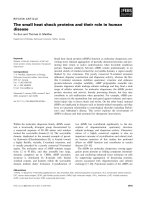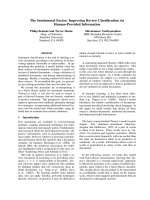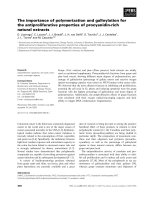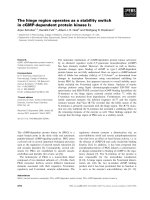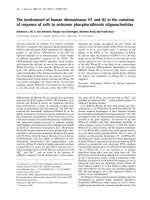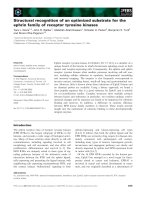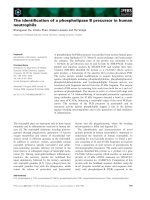Báo cáo khoa học: "The Treegram Index An Efficient Technique for Retrieval in Linguistic Treebanks" docx
Bạn đang xem bản rút gọn của tài liệu. Xem và tải ngay bản đầy đủ của tài liệu tại đây (159.01 KB, 2 trang )
Proceedings
of EACL '99
The Treegram Index An Efficient Technique for Retrieval in
Linguistic Treebanks
Hans Argenton and Anke Feldhaus
Infineon Technologies, DAT CIF, Postbox 801709, D-81617 Miinchen
University of Tiibingen, SfS, Kleine Wilhelmstr.113, D-72074 Tiibingen
Multiway trees (MT, henceforth) are a
common and well-understood data struc-
ture for describing hierarchical linguistic
information. With the availability of large
treebanks, retrieval techniques for highly
structured data now become essential. In
this contribution, we investigate the effi-
cient retrieval of MT structures at the cost
of a complex index the
Treegram Index.
We illustrate our approach with the
VENONA
retrieval system, which han-
dles the BH t (Biblia Hebraica transeripta)
treebank comprising 508,650 phrase struc-
ture trees with maximum degree eight and
maximum height 17, containing altogether
3.3 million Old-Hebrew words.
1 Multiway-tree
retrieval based on
treegrams
The base entities of the tree-retrieval
problem for positional MTs are (labeled)
rooted MTs where children are distin-
guished by their position.
Let s and t be two MTs;
t contains s
(written as s ~ t) if there exists an in-
jective embedding such that (1) nodes are
mapped to nodes with identical labels and
(2) a root of a child with position i is
mapped to a root of a child with the same
position.
Retrieval problem: Let DB be a set
of' labeled positional MTs and let q be a
query tree having the same label alphabet.
The problem is to find efficiently all trees
t C DB that contain q.
To cope with this tree-retrieval problem,
we generalize the well-known n-gram in-
dexing technique for text databases: In
place of substrings with fixed length, we
use subtrees with fixed maximal height
treegrams.
Let TG(t,h) denote the set of all tree-
grams of height h contained in the MT
t, and let T(DB, g) denote the set of all
database trees that contain the treegram
g. Assume that g has the height h and
that T(DB, g) can be efficiently computed
using the index relation I~B := {(g,
t)lt E
DB A g C TG(t, h)}, which lists for each
treegram g of height h every database tree
that contains g. We compute the desired
result set R = {t C DBIq ___ t} for a given
query tree q such that q's height is greater
than or equal h as follows:
Retrieval method:
(1)
Compute the set TG(q,h): All tree-
grams of height h contained in the
query.
(2)
Compute the
candidate set of"
(t
Candh(q) := Ng~Ta(q,h ) T(DB, g).
The set of all database trees that con-
tain every query treegram.
(3) Compute the
result set R = {t E
Cand~(q)l q ! t}.
The costly operation in this approach is
the last containment test q _ t. The build-
ing of index Ihs is justified if in general tile
267
Proceedings of EACL '99
number of candidateswill be much smaller
than the number of trees in DB.
2 Efficient query evaluation
The treegram-index retrieval method given
above encounters the following interesting
problems:
(A)
A single treegram may be very com-
plex because of its unlimited degree
and label strings; this leads to costly
look-up operations.
(B)
There are many treegrams rooting at
a given node in a database tree: To
accomodate queries with subtree vari-
ables, the index has to contain all
matching treegrams for that subtree.
(c)
It is quite expensive to intersect the
tree sets T(DB, g) for all treegrams g
contained in the query q.
VENONA addresses these problems by the
following approach:
Problem A:
Processing of a single tree-
gram:
(1) Node labels hash to an integer
of a few bytes: We do not consider labels
structured; to model the structure of word
forms, feature terms should be used 1. (2)
VENONA
deals only with treegrams of a
maximal degree d; if a tree is of greater
degree, it will be transformed automati-
cally to a d-ary tree. 2 (3) For describing
a single treegram g, VENONA takes each
of g's hashed labels and combines it with
the position of its corresponding node in
a complete d-ary tree; an integer encod-
ing g's structure completes this represen-
tation: Structure is at least as essential for
tree retrieval as label information.
1Due to lack of space, we cannot present our ex-
tension of treegram indexing to feature terms in this
abstract.
2The employed algorithm is a generalization of
the
well-known transformation
of trees
to binary trees.
d's
value is a configurable parameter of the index-
generation.
Problem B
VENONA
uses only one tree-
gram per node v: the treegram includ-
ing
every
node found on the first h lev-
els of the subtree rooted in v. This ap-
proach keeps the index small but intro-
duces another problem: A query treegram
may not appear in the treegram index as it
is. Therefore, VENONA expands all query
treegram
structures
at runtime; for a given
query treegram g, this expansion yields all
database treegrams with a structure com-
patible to g. That approach keeps the tree-
gram index small and preserves efficiency.
Problem C The evaluation of a given
query q is processed along the following
steps: (1) According to q's degree and
height,
VENONA
chooses a treegram in-
dex among those available for the tree
database. (2) VENONA collects
q's
tree-
grams and represents them by sets of tree-
gram parts. For a given query treegram,
VENONA
expands the structure number to
a set of index treegram structures and re-
moves those labels that consist of a vari-
able: Variables and the constraints that
they impose belong to the matching phase.
(3)
VENONA sorts q's treegrams according
to their .selectivity by estimating a tree-
gram's selectivity based on the selectivity
of its treegram parts. (4) VENONA esti-
mates how many query treegrams it has
to evaluate to yield a candidate set small
enough for the tree matcher; only for those
it determines the corresponding index tree-
grams. (5) VENONA processes these se-
lected treegrams until the candidate set
has the desired size if necessary, falling
back on some of the treegrams put aside.
(6) Finally, the tree matcher selects the an-
swer trees from these candidates.
268

